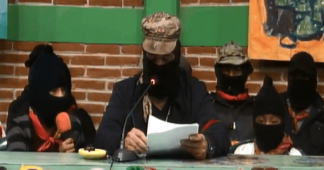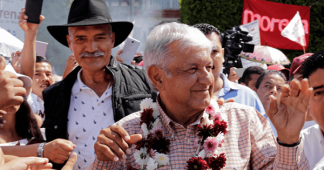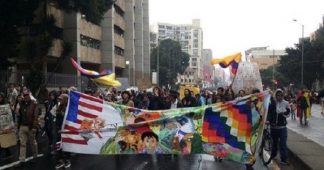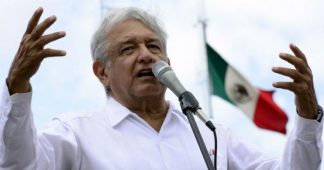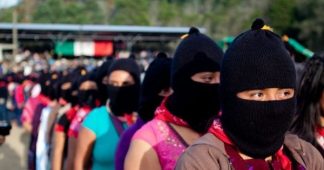By Leonidas Oikonomakis
August 19, 2019
It all started, in typical Zapatista fashion, with the publication of four new communiqués signed by Subcomandante Insurgente Galeano (formerly known as Marcos) between August 10 and 15. The first one, titled Enter el telonero (“The Opening Act”), ended on a mysterious note:
“Look, ladies, gentlemen, and others
Nothing to see here, nothing to see there, but wait, all of a sudden, boom:
The Zapatista communities (re)appear…”
Those familiar with the Subcomandante’s literary style already knew that something big was about to follow.
The communiqués analyze the political reality in Mexico and the challenges faced by Indigenous peoples under AMLO’s presidency and his so-called “Fourth Transformation”, which presumes AMLO’s term in office to leave a historical footprint similar to that of the Mexican Revolution and the country’s independence from Spain.
Thus far, AMLO’s rule has been characterized by a typical capitalist drive for the exploitation of the environment and the extraction of natural resources, not that dissimilar from his more conservative predecessors, despite the progressive rhetoric. AMLO’s “megaprojects” — among which the Maya Train, the Trans-Isthmus Corridor and the Project Sembrando Vida (Planting Life) — are particularly illustrative of the new administration’s disregard for the environment and its Indigenous protectors.
The top-down nature of these projects, along with the threats they pose to the well-being of both social and natural environments across the country in general, and to Zapatista communities in particular, have led the Zapatistas to condemn these in the strongest terms.
They also highlight the fact that during AMLO’s presidency a number of Indigenous defenders of Mother Earth and members of the National Indigenous Congress (CNI), in which the Zapatistas also participate, have been assassinated under highly suspicious circumstances. The most well-known case is that of Samir Flores Soberanes, an Indigenous journalist and environmental activist who was assassinated for campaigning against the Proyecto Integral Morelos — a controversial plan to build a thermoelectric plant and a gas pipeline in Morelos, his home state.
But the real news was announced in a communiqué signed by Subcomandante Insurgente Moisès, published on August 17: the Zapatistas have created seven new caracoles and four new Autonomous Municipalities (MAREZ)! In doing so, they have significantly expanded the structural and organizational capacity of Zapatista Autonomy. Honoring Samir and the many other targeted social and environmental rights defenders, the Zapatistas have named their initiative “Samir Flores Soberanes.”
Ironically, while AMLO aspired for his presidency to form a critical juncture for the country, it is now some of his loudest critics on the left who appear to be stealing the show. The creation of seven new caracoles and four new MAREZ marks the most historically significant moment for the Zapatistas since 2003, when the formation of the five currently existing caracoles was announced. The expansion also signifies an impressive growth in the organizational capacity of the movement, which has now led to the creation of these new Zapatista centers. It is the movement’s social and territorial expansion that led to the need for more caracoles and MAREZ.
Electoral tactics, autonomous strategies
This historical development did not occur in a socio-political vacuum. It is in fact the result of an internal re-organization of the movement that was quietly pursued over the past few years. Moreover, for the past months Zapatista communities have been closed to outsiders, and even the few communities that were open to Human Rights Observers in the past have been closed for some time now. Only La Realidad, where maestro Galeano was assassinated some years ago, remained open throughout this period.
This “internal closure” may have had something to do with the organizational expansion that has now been publicly announced: the Zapatistas did not want their plans revealed until they were ready to reveal them to the world themselves — until now, in other words.
In addition, the expansion of Zapatista Autonomy comes as an answer to the critics among the Mexican and international left — in particular among the anarchist movement — that accused Zapatismo of taking an “electoral turn” when in 2016 they backed Maria de Jesus Patricio Martinez, an Indigenous woman, as a joint candidate together with the CNI for the 2018 presidential elections.
At the time, many viewed it as a strategic turn of the movement, while others viewed it as a tactic. The latter interpretation seems to be closer to the truth, since the Zapatistas clearly have not abandoned the construction of their autonomous self-governance — on the contrary, they are now expanding it, both in social and organizational terms.
The new Zapatista communities
With Subcomandante Insurgente Moisès’ announcement regarding the creation of 11 new CRAREZ (Centros de Resistència Autònoma y Rebeldìa Zapatista, or Zapatista Centres of Autonomous Resistance and Rebellion — a newly-introduced collective name for both caracoles and autonomous municipalities), the total number of CRAREZ is now 43: 12 caracoles and 31 MAREZ.
In Moisès’ words, the new CRAREZ are the following:
New caracoles:
-
Colectivo el corazón de semillas rebeldes, memoria del Compañero Galeano (The heart of rebellious seeds collective, memory of Comrade Galeano). Its Junta de Buen Gobierno/ Good Government Council is called: Pasos de la historia, por la vida de la humanidad (Steps of History, for the life of Humanity). Its organizational center is La Unión, next to San Quintín, on recuperated land next to military barracks.
-
Espiral digno tejiendo los colores de la humanidad en memoria de l@s caídos (Dignified spiral weaving the colors of humanity in memory of the fallen ones). Its Junta de Buen Gobierno/Good Government Council is called: Semilla que florece con la conciencia de l@s que luchan por siempre (Seed that flourishes with the conscience of those who struggle forever).
-
Floreciendo la semilla rebelde (Flourishing the rebellious seed). Its Junta de Buen Gobierno/Good Government Council is called: Nuevo amanecer en resistencia y rebeldía por la vida y la humanidad (New Dawn in resistance and rebellion for life and humanity). Its organizational center is in el Poblado Patria Nueva, recuperated land. Official municipality of Ocosingo.
-
En honor a la memoria del Compañero Manuel (In honor of the memory of Comrade Manuel). Its Junta de Buen Gobierno/Good Govenment Council is called: El pensamiento rebelde de los pueblos originarios (The rebelious thinking of the original peoples). Its organizational center is in Dolores Hidalgo, recuperated land. Official municipality of Ocosingo.
-
Resistencia y rebeldía un nuevo horizonte (Resistance and rebellion, a new horizon). Its Junta de Buen Gobierno/Good Government Council is called: La luz que resplandece al mundo (The light that shines on the world). Its organizational center is in el Poblado Nuevo Jerusalén, recuperated land. Official municipality of Ocosingo.
-
Raíz de las resistencias y rebeldías por la humanidad (Root of the resistances and the rebellions for humanity). Its Junta de Buen Gobierno/Good Government Council is called: Corazón de nuestras vidas para el nuevo futuro (Heart of our lives for the new future). Its organizational center is in ejido Jolj’a. Official municipality of Tila.
-
Jacinto Canek (a famous 18th century Mayan revolutionary). Its Junta de Buen Gobierno/Good Government Council is called: Flor de nuestra palabra y luz de nuestros pueblos que refleja para todos (Flower of our word and light of our people that reflects for all). Its organizational center is in Comunidad del CIDECI-Unitierra. Official municipality of San Cristóbal de las Casas.
The new Autonomous Municipalities (MAREZ)
-
Esperanza de la Humanidad (Hope of Humanity). Its organizational center is in ejido Santa María. Official municipality of Chicomuselo.
-
Ernesto Che Guevara. Its organizational center is in El Belén. Official municipality of Motozintla.
-
Sembrando conciencia para cosechar revoluciones por la vida (Planting consciousness in order to harvest revolutions for life). Its organizational center is in Tulan Ka’u, recuperated land. Official municipality of Amatenango del Valle.
-
21 de Diciembre (December 21). Its organizational center is in Ranchería K’anal Hulub. Official municipality of Chilón.
The Zapatistas also invite the adherents to the Sixth Declaration, the members of the CNI-CIG, and the international community to participate in the construction of the new CRAREZ in any way they can: by sending money, construction material, or even with manual labor.
Details of how that can be done will follow in an upcoming communiqué, as promised by Subcomandante Insurgente Moisès.
A new Zapatista era
A lot will be written and even more will be revealed later on regarding this new Zapatista initiative. What is sure at this stage is that the birth of the 11 new Zapatista centers marks, first, a critical juncture in the history of Zapatismo, the most important after the birth of the first five caracoles in 2003. Second, it signals the end of a long period of internal reorganization on behalf of the movement, which has decided to open itself up to the world again, “breaking the siege” under which they had found themselves, as Moisès described the situation in his latest communique.
n addition, the Zapatistas, with Subcomandante Insurgente Galeano’s new communiqués, take position on the frontlines of the struggle against climate change, which is a struggle against capitalism:
“Nature is an elastic wall that multiplies the velocity of the stones we throw at it. Death doesn’t bounce back in the same proportion, but rather enforced. There is a war between the system and nature. This confrontation can’t take either nuances or cowardice. Either you are on the side of the system, or on that of nature. Either with death, or with life.”
The Zapatistas have certainly broken the siege.
Òrale!
Published at https://roarmag.org/essays/zapatistas-announce-major-expansion-of-autonomous-territories/
